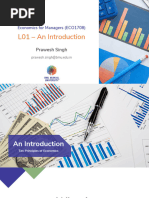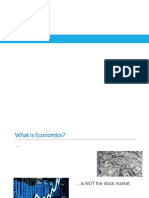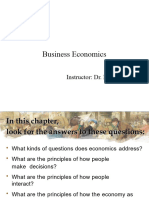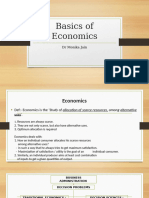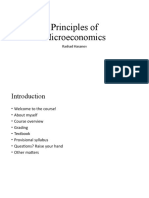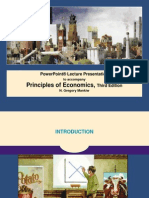Parkin Econ Ch01-Notes
Parkin Econ Ch01-Notes
Uploaded by
barros8811Copyright:
Available Formats
Parkin Econ Ch01-Notes
Parkin Econ Ch01-Notes
Uploaded by
barros8811Copyright
Available Formats
Share this document
Did you find this document useful?
Is this content inappropriate?
Copyright:
Available Formats
Parkin Econ Ch01-Notes
Parkin Econ Ch01-Notes
Uploaded by
barros8811Copyright:
Available Formats
1 WHAT IS ECONOMICS?
Lecture Notes
What Is Economics?
I. Definition of Economics
• Economic questions arise because we always want more than we can get, so we face scarcity, the inability
to satisfy all our wants. Everyone faces scarcity because no one can satisfy all of his or her wants.
• Scarcity forces us to make choices over the available alternative. The choices we make depend on
incentives, a reward that encourages a choice or a penalty that discourages a choice.
Bill Gates and Warren Buffet are two wealthiest businessmen. Do they face scarcity? According to The Wall Street
Journal, both men are ardent bridge players, yet they have never won one of the many national bridge tournaments
they have entered as a team. They can easily afford the best bridge coaches in the world, but they don’t allocate
enough time to practicing as much as they would need to win. They face scarcity (of time) and must choose how to
spend their time.
Economics
• Economics is the social science that studies the choices that individuals, businesses, governments, and
entire societies make when they cope with scarcity and the incentives that influence and reconcile those
choices.
• Economists work to understand when the pursuit of self-interest advances the social interest
• Economics is divided into microeconomics and macroeconomics:
• Microeconomics is the study of the choices that individuals and businesses make, the way these
choices interact in markets, and the influence of governments.
• Macroeconomics is the study of the performance of the national economy and the global
economics.
The definition in the text: “Economics is the social science that studies the choices that individuals, businesses,
governments, and societies make as they cope with scarcity and the incentives that influence and reconcile these
choices,” is a modern language version of Lionel Robbins famous definition, “Economics is the science which
studies human behaviour as a relationship between ends and scarce means that have alternative uses.”
Other definitions include those of Keynes and Marshall:
John Maynard Keynes: “The theory of economics does not furnish a body of settled conclusions immediately
applicable to policy. It is a method rather than a doctrine, an apparatus of the mind, a technique of thinking, which
helps it possessors to draw correct conclusions.”
Alfred Marshall: “Economics is a study of mankind in the ordinary business of life; it examines that part of
individual and social action which is most closely connected with the attainment and with the use of the material
requisites of wellbeing.”
II. Two Big Economic Questions
Copyright © 2013 Pearson Canada Inc.
1
2 CHAPTER 1
How do choices wind up determining what, how, and for whom goods and services are
produced?
What, How and For Whom?
• Goods and services are the objects that people value and produce to satisfy human wants. What we
produce changes over time—today we produce more DVDs and fewer video tapes than five years ago.
• Goods and services are produced using productive resources called factors of production. These are
land (the “gifts of nature”, natural resources), labour (the work time and work effort people devote to
production), capital (the tools, instruments, machines, buildings, and other constructions used to produce
goods and services), and entrepreneurship (the human resource that organizes labour, land, and capital).
• The quality of labour depends on human capital, which is the knowledge and skill that people obtain
from education, work experience, and on-the-job training.
• Owners of the factors Land earns rent, labour earns wages, capital earns interest, and entrepreneurship
earns profit.
When is the pursuit of self-interest in the social interest?
• People make choices that they think are best for them, that is, choices in their self-interest.
• Choices that are the best for society as a whole are said to be in the social interest.
• A major question economists explore is “Could it be possible that when each of us makes choices in our
self-interest, these choices are in the social interest?”
• We can examine whether the self-interested choices serve the social interest for a variety topics:
• Globalization: Buying an iPod allows workers overseas to earn a wage and provide for family
• The information-age economy: A firm producing popular software leads to format standards
• Climate chang: Carbon dioxide emissions led to higher global temperatures and climate change
• Economic instability: Volatility and risk in financial markets leads to less student lending available
III. Economic Way of Thinking
Scarcity requires choices and choices create tradeoffs.
A Choice is a Tradeoff
• A tradeoff is an exchange—giving up one thing to get another.
• Whatever choice you make, you could have chosen something else.
Making a Rational Choice
• A rational choice is one that compares costs and benefits and achieves the greatest benefit over cost for
the person making the choice.
• But how do people choose rationally? Why do more people choose an iPod rather than a Zune? Why has
the Canadian government chosen to build a national highway system and not a national high-speed rail
system? The answers turn on comparing benefits and costs.
Benefit: What you Gain
• The benefit of something is the gain or pleasure that it brings and is determined by preferences—by
what a person likes and dislikes and the intensity of those feelings.
• Some benefits are large and easy to identify, such as the benefit that you get from being in school. Much of
that benefit is the additional goods and services that you will be able to enjoy with the boost to your earning
power when you graduate.
Copyright © 2013 Pearson Canada Inc.
2
W HAT IS ECONOMICS? 3
• Some benefits are small, such as the benefit you get from a slice of pizza. That benefit is just the pleasure
and nutrition that you get from your pizza.
Cost: What You Must Give Up
• Seeing choices as tradeoffs shows there is an opportunity cost of a choice. The opportunity cost of
something is the highest-valued alternative that must be given up to get it. So, for instance, the opportunity
cost of being in school is all the good things that you can’t afford and don’t have the spare time to enjoy.
To ensure that people do not die of any serious side effects, the government requires all drug companies to
thoroughly test newly developed medicines before allowing them to be sold in Canada. However, it takes many
years to perform these tests and many people suffering from the terminal diseases these new medicines are designed
to cure will die before good new medicines are eventually approved for use. Yet, if the government were to abandon
this testing process, many others would die from the serious side effects of those bad medicines that made it to
market. People’s lives will be at risk under either policy alternative. This stark example of a tradeoff reveals the idea
that choices have opportunity costs.
Choosing at the Margin
• Making choices at the margin means looking at the tradeoffs that arise from making small changes in an
activity. People make choices at the margin by comparing the benefit from a small change in an activity
(which is the marginal benefit) to the cost of making a small change in an activity (which is the
marginal cost).
• Changes in marginal benefits and marginal costs alter the incentives that we face when making choices.
When incentives change, people’s decisions change.
• For example, if homework assignments are weighed more heavily in a class’s final grade, the marginal
benefit of completing homework assignments has increased and more students will do the homework.
Human Nature, Incentives, and Institutions
• Economists take human nature as given and view people acting in their self-interest.
• Self-interest actions are not necessarily selfish actions.
IV. Economics as Social Science and Policy Tool
Economics as Social Science
• Economists distinguish between positive statements and normative statements. A positive statement is about
“what is” and is testable. A normative statement is about “what ought to be” and is an opinion and so is
inherently not testable. A positive statement is “Raising the tax on gasoline will raise the price of gasoline and
lead more people to buy smaller cars” while a normative statement is “The tax on a litre of gasoline should be
raised.”
• Economists tend to agree on positive statements, though they might disagree on normative statements.
• An economic model describes some aspect of the economic world that includes only those features
needed for the purpose at hand. Economic models describe the economic world in the same way that a road
map explains the road system: Both focus on only what is important and both are abstract depictions of the
real word.
• Testing an economic model can be difficult, given we observe the outcomes of the simultaneous
operation of many factors. So, economists use the following to copy with the problem:
1. Natural experiment: A situation that arises in the ordinary course of economic life in which the
one factor of interest is different and other things are equal or similar.
Copyright © 2013 Pearson Canada Inc.
3
4 CHAPTER 1
2. Statistical Investigation: A statistical investigation might look for the correlation of two
variables, to see if there is some tendency for the two variables to move in a predictable and
related way (e.g. cigarette smoking and lung cancer).
3. Economic Experiment: Putting people in a decision-making situation and varying the influence
of one factor at a time to see how they respond.
Economist as Policy Adviser
• Economics is useful. It is a toolkit for advising governments and businesses and for making personal
decisions.
• For a given goal, economics provides a method of evaluating alternative solutions—comparing marginal
benefits and marginal costs and finding the solution that makes the best use of the available resources.
The success of a model is judged by its ability to predict. No matter how abstract or far removed from reality a
model appears to be, if it predicts well, it is valuable.
Milton Friedman’s Pool Hall example illustrates the point nicely. Imagine a physicist’s model that predicts where
a carefully placed shot of a pool shark would go as he tries to sink the eight ball into the corner pocket. The model
would be a complex, trigonometric equation involving a plethora of Greek symbols that no ordinary person would
even recognize as representing a pool shot. It certainly wouldn’t depict what we actually see—a pool stick striking a
pool cue on a rectangular patch of green felt. It wouldn’t even reflect the thought processes of the pool shark that
relies on years of experience and the right “touch.” Yet, constructed correctly, this mathematical model would
predict exactly where the cue ball would strike the eight ball, hit opposite the bank, and fall into the corner pocket.
Graphs in Economics Lecture Notes
Lecture Notes
I. Graphing Data
• Graphs are valuable tools that clarify what otherwise might be obscure relationships.
• Graphs represent “quantity” as a distance. Two-variable graphs use two perpendicular scale
lines. The vertical line is the y-axis. The horizontal line is the x-axis. The zero point in
common to both axes is the origin.
• Scatter diagram—a graph that plots the value of one variable on the x-axis and the value of the
associated variable on the y-axis. A scatter diagram can make clear the relationship between two variables.
II. Graphs Used in Economic Models
• Graphs are used to show the relationship between variables. Graphs can immediately convey the
relationship between the variables:
• A positive relationship (or direct relationship)—when the variable on the x-axis increases the
variable on the y-axis increases. A straight line is a linear relationship.
• A negative relationship (or inverse relationship)—when the variable on the x-axis increases,
the variable on the y-axis decreases.
• A maximum or a minimum—when the variable has a highest or lowest value.
III. The Slope of a Relationship
• The slope of a curve equals the change in the value of the variable on the vertical axis at the point where
the slope is being calculated divided by the change in the value of the variable on the horizontal axis at the
relevant point.
Copyright © 2013 Pearson Canada Inc.
4
W HAT IS ECONOMICS? 5
• In terms of symbols, the slope equals y/x, with standing for “change in.”
• The slope of a straight line is constant. The slope is positive if the variables are positively related and
negative if the variables are negatively related.
• The slope of a curved line at a point equals the slope of the straight line that is tangent to the curved line at
the point.
• The slope of a curved line across an arc equals the slope of the straight line between the two points on the
curved line.
VI. Graphing Relationships Among More Than Two Variables
• A. When a relationship involves more than two variables, we can plot the relationship between two of the
variables by holding other variables constant.
Copyright © 2013 Pearson Canada Inc.
5
You might also like
- Eco Notes For Mid Sem - 230916 - 103512No ratings yetEco Notes For Mid Sem - 230916 - 103512141 pages
- Lec01 Econ104 Introduction To Microeconomics 2019No ratings yetLec01 Econ104 Introduction To Microeconomics 201966 pages
- Chapter 1: Introduction To Economics: Intended Learning OutcomesNo ratings yetChapter 1: Introduction To Economics: Intended Learning Outcomes9 pages
- Objectives: After Studying This Section, You Will Be Able ToNo ratings yetObjectives: After Studying This Section, You Will Be Able To33 pages
- 1 Introduction To Economics (1) BHHVHVVNo ratings yet1 Introduction To Economics (1) BHHVHVV29 pages
- CH 1what Is Eco 07102021 100009pm 26092022 125030pm 1 23022023 112201am 20092023 121641pm 19022024 115003am 09092024 115636amNo ratings yetCH 1what Is Eco 07102021 100009pm 26092022 125030pm 1 23022023 112201am 20092023 121641pm 19022024 115003am 09092024 115636am25 pages
- Session 1. Seven Principles of EconomicsNo ratings yetSession 1. Seven Principles of Economics15 pages
- Chapter 1 Introduction in Microeconomics: Dr. ShonNo ratings yetChapter 1 Introduction in Microeconomics: Dr. Shon66 pages
- Basic Economics Ideas and Resource AllocationNo ratings yetBasic Economics Ideas and Resource Allocation10 pages
- Course Title: Building Economics: Prepared byNo ratings yetCourse Title: Building Economics: Prepared by72 pages
- First Principles: Slides Created by Dr. Amy ScottNo ratings yetFirst Principles: Slides Created by Dr. Amy Scott33 pages
- Economy. - .: Ten Principles of EconomicsNo ratings yetEconomy. - .: Ten Principles of Economics5 pages
- Lecture Notes 1 Course Overview and IntroductionNo ratings yetLecture Notes 1 Course Overview and Introduction62 pages
- Principles of Economics,: Powerpoint® Lecture PresentationNo ratings yetPrinciples of Economics,: Powerpoint® Lecture Presentation30 pages
- Use The Data and Your Economic Knowledge To Assess The View That Living Standards in The UK Are Likely To Benefit From Sustained Economic Growth in The Economies of Africa100% (1)Use The Data and Your Economic Knowledge To Assess The View That Living Standards in The UK Are Likely To Benefit From Sustained Economic Growth in The Economies of Africa2 pages
- Unit 5 Level and Structure of Interest RatesNo ratings yetUnit 5 Level and Structure of Interest Rates28 pages
- OneSumXY Risk - General Risk PresentationNo ratings yetOneSumXY Risk - General Risk Presentation61 pages
- Human Computer Interactionwith Multivariate Sentiment Distributionsof Stocks Intraday Camera ReadyNo ratings yetHuman Computer Interactionwith Multivariate Sentiment Distributionsof Stocks Intraday Camera Ready8 pages
- Time and Tense: Find The Error: Assignment 1No ratings yetTime and Tense: Find The Error: Assignment 131 pages
- Josef Steindl and Capitalist StagnationNo ratings yetJosef Steindl and Capitalist Stagnation19 pages
- Economics Sylabus III - IV Semester-MinNo ratings yetEconomics Sylabus III - IV Semester-Min77 pages
- Revised Programme of Examination According To Jnvu SyllabusNo ratings yetRevised Programme of Examination According To Jnvu Syllabus10 pages
- List of Participants: National Government Officials Brunei DarussalamNo ratings yetList of Participants: National Government Officials Brunei Darussalam8 pages
- الحمائية الجديدة و التحرير التجاري الدولي في ظل شروط المنظمة العالمية للتجارة وواقع متغيرات الإقتصاد الدوليNo ratings yetالحمائية الجديدة و التحرير التجاري الدولي في ظل شروط المنظمة العالمية للتجارة وواقع متغيرات الإقتصاد الدولي26 pages
- CIR v. Traders Royal Bank, G.R. No. 167134, March 18, 2015 FactsNo ratings yetCIR v. Traders Royal Bank, G.R. No. 167134, March 18, 2015 Facts1 page
- 3 Rules For Choosing Your: First Million Dollar ProductNo ratings yet3 Rules For Choosing Your: First Million Dollar Product17 pages
- Chapter 1: Introduction To Economics: Intended Learning OutcomesChapter 1: Introduction To Economics: Intended Learning Outcomes
- Objectives: After Studying This Section, You Will Be Able ToObjectives: After Studying This Section, You Will Be Able To
- CH 1what Is Eco 07102021 100009pm 26092022 125030pm 1 23022023 112201am 20092023 121641pm 19022024 115003am 09092024 115636amCH 1what Is Eco 07102021 100009pm 26092022 125030pm 1 23022023 112201am 20092023 121641pm 19022024 115003am 09092024 115636am
- Chapter 1 Introduction in Microeconomics: Dr. ShonChapter 1 Introduction in Microeconomics: Dr. Shon
- Principles of Economics,: Powerpoint® Lecture PresentationPrinciples of Economics,: Powerpoint® Lecture Presentation
- Gale Researcher Guide for: The Work That Economists DoFrom EverandGale Researcher Guide for: The Work That Economists Do
- Use The Data and Your Economic Knowledge To Assess The View That Living Standards in The UK Are Likely To Benefit From Sustained Economic Growth in The Economies of AfricaUse The Data and Your Economic Knowledge To Assess The View That Living Standards in The UK Are Likely To Benefit From Sustained Economic Growth in The Economies of Africa
- Human Computer Interactionwith Multivariate Sentiment Distributionsof Stocks Intraday Camera ReadyHuman Computer Interactionwith Multivariate Sentiment Distributionsof Stocks Intraday Camera Ready
- Revised Programme of Examination According To Jnvu SyllabusRevised Programme of Examination According To Jnvu Syllabus
- List of Participants: National Government Officials Brunei DarussalamList of Participants: National Government Officials Brunei Darussalam
- الحمائية الجديدة و التحرير التجاري الدولي في ظل شروط المنظمة العالمية للتجارة وواقع متغيرات الإقتصاد الدوليالحمائية الجديدة و التحرير التجاري الدولي في ظل شروط المنظمة العالمية للتجارة وواقع متغيرات الإقتصاد الدولي
- CIR v. Traders Royal Bank, G.R. No. 167134, March 18, 2015 FactsCIR v. Traders Royal Bank, G.R. No. 167134, March 18, 2015 Facts
- 3 Rules For Choosing Your: First Million Dollar Product3 Rules For Choosing Your: First Million Dollar Product












